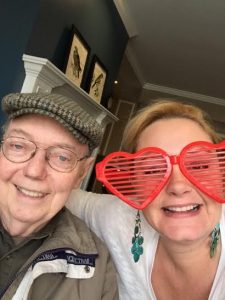
Launching a volunteer program in your memory care community can improve the care and engagement of persons with dementia. The life experiences and talents of energetic and motivated volunteers can complement the gifts of your well-trained staff. Volunteers may play the piano, create and lead art and music programs, accompany groups on field trips, or serve on boards or committees—always with the Knack of great care.
I’ve seen volunteers add so much to the Best Friends Day Center in Lexington, Kentucky, since it opened in 1984. Many have volunteered for over 20 years! They often express great joy in being a Best Friend with participants at the Center. They also find that it is very difficult to help another without being helped yourself. That’s the double serendipity of being a volunteer Best Friend.
In my experience, these are the steps to starting a successful volunteer program:
1. Write a purpose statement for your program. What’s your vision? How can you weave the Best Friends™ Approach through it?
2. Do a self-assessment and set goals. Volunteers take time. Are you ready? Do you have a designated volunteer coordinator? Is staff and management ready to embrace volunteers? Can you offer meaningful work–not just have people stuff envelopes? Is it realistic to set a goal to train and place five people during the first program year? Ten?
3. Develop job descriptions. Even the simplest volunteer assignment needs a real job description. A description can help volunteers understand the responsibilities they will be assigned and how the position helps your organization and persons with dementia.
4. Creatively recruit and interview. Volunteerism is not declining! Lots of people want to volunteer to do something meaningful, especially recent retirees. After all, they have degrees rusting in the attic! Start by approaching people you know who would make great volunteers. Consider family care partners who are no longer providing care to their own family members. Or brainstorm a list of talents that would benefit your residents, and set out to find those people: a person with a friendly pet therapy dog who can visit once a week, or a musician who can play the piano for half an hour before dinner.
5. Provide meaningful orientation and training. At the Best Friends Day Center, we used to tell people they couldn’t volunteer until they had completed the training. Now we say come, spend time with us, get the feel of the place, and then take the training. We stretch our orientation and training out over a few weeks so people really learn the Best Friends™ Approach. At the beginning, a neurologist gives a session on what dementia is and isn’t. Then we have sessions on the Best Friends philosophy, the do’s and don’ts of being a volunteer, the Life Story, and communication skills. We also have ongoing workshops and training so our volunteers can continue to learn. Volunteers are not “just volunteers”. They relate and communicate in ways that can be life changing for persons with dementia.
Helping volunteers know how to use the life story is critical. If a volunteer can bring something from the life story to the surface (Rhonda, weren’t you on the city council?) then a person with dementia can key into it and share even more. If volunteer can initiate a topic, it’s amazing what they will learn from their Best Friends, and how good the exchange will make the person feel.
6. Create a satisfying experience. I believe a satisfying experience includes work that is significant and a strong group identity that is reinforced through regular opportunities for volunteers to get to know one another. Each day people volunteer at the Best Friends Day Center, it’s like a family. Volunteers share their joys and sorrows, and enjoy a monthly continuing education lunch together. They know each other’s life story, plus those of participants.
7. Say thank you in many ways. Be specific. Goodie, I love the way you listen to George when he is struggling with conversation. Regular appreciation meals and events are also appreciated. Keep track of hours worked and give certificates acknowledging milestones like 100 hours or 1 year of service.
The really amazing thing about the Best Friends Day Center in Lexington is that we have had two people who were volunteers transition to being participants. At first they could still do some helping, but gradually they became participants. They just blended in without ever stopping. It was beautiful. When you have a Best Friend sitting beside you, you are not “us and them”. You’re friends together.
